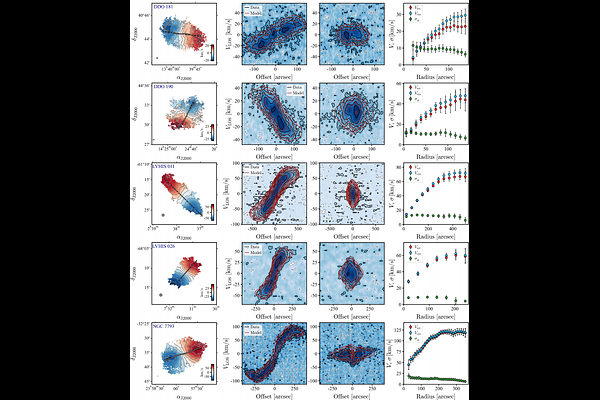The galaxy-halo connection of disc galaxies over six orders of magnitude in stellar mass

The galaxy-halo connection of disc galaxies over six orders of magnitude in stellar mass
Pavel E. Mancera Piña, Justin I. Read, Stacy Kim, Antonino Marasco, José A. Benavides, Marcin Glowacki, Gabriele Pezzulli, Claudia del P. Lagos
Abstract(Abridged) The relations between stellar ($M_\ast$), gas ($M_{\rm gas}$), baryonic ($M_{\rm bar} = M_\ast + M_{\rm gas}$), and dark matter halo mass ($M_{200}$) provide unique constraints on galaxy formation and cosmology. The shape of the relations constrains how galaxies regulate their growth through gas accretion, star formation, and feedback; their scatter probes the stochasticity of galaxy assembly. Here, we assemble a sample of 49 nearby gas-rich dwarf and massive disc galaxies with unmatched ancillary data. We obtain their gas kinematics and derive their dark matter properties through rotation curve decomposition. Our sample allows us to study the galaxy-halo connection across nearly six orders of magnitude in $M_\ast$. We find that the $M_{\rm gas}-M_{200}$ relation rises monotonically, with galaxies having around 4 per cent of the average cosmological baryon fraction in cold gas. Contrastingly, the $M_\ast-M_{200}$ relation shows a more complex behaviour. A particularly interesting finding is that of a population of baryon-deficient' dwarfs (BDDs) with stellar masses $\sim 1-1.5$ orders of magnitude lower than expected from current models. Yet, baryon-rich galaxies also exist, and we find a large spread in the baryon retention fraction across our galaxies. We compare our findings with semi-analytic and hydrodynamical galaxy formation simulations. While the simulations broadly reproduce most observed features, they struggle to match the BDDs and do not capture the diversity in baryon fractions. Understanding these differences will shed new light on how feedback regulates galaxy formation. Finally, we study the dark matter halo concentration-mass relation. We find that below $M_{200} \sim 10^{11}\,M_\odot$, the concentrations are systematically lower than expected. We discuss whether these results stem from the influence of baryonic physics or the environment.